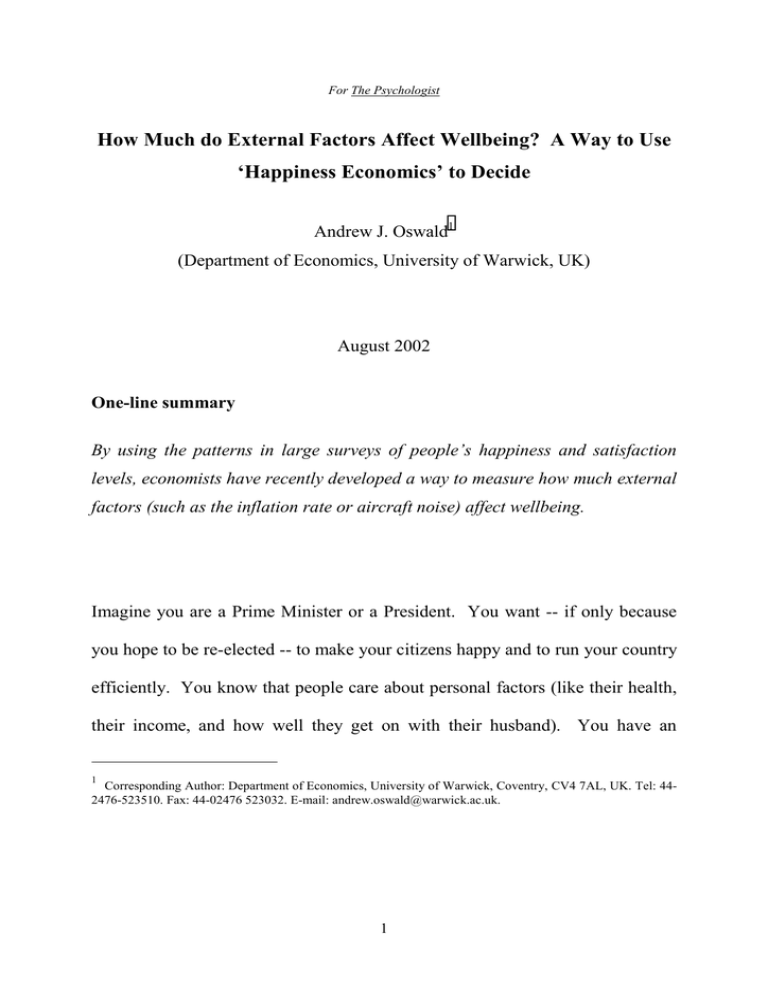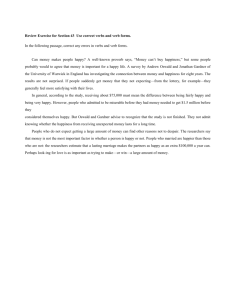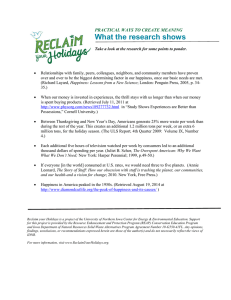How Much do External Factors Affect Wellbeing? A Way... ‘Happiness Economics’ to Decide
advertisement

For The Psychologist How Much do External Factors Affect Wellbeing? A Way to Use ‘Happiness Economics’ to Decide Andrew J. Oswald1 (Department of Economics, University of Warwick, UK) August 2002 One-line summary By using the patterns in large surveys of people’s happiness and satisfaction levels, economists have recently developed a way to measure how much external factors (such as the inflation rate or aircraft noise) affect wellbeing. Imagine you are a Prime Minister or a President. You want -- if only because you hope to be re-elected -- to make your citizens happy and to run your country efficiently. You know that people care about personal factors (like their health, their income, and how well they get on with their husband). You have an 1 Corresponding Author: Department of Economics, University of Warwick, Coventry, CV4 7AL, UK. Tel: 442476-523510. Fax: 44-02476 523032. E-mail: andrew.oswald@warwick.ac.uk. 1 intuitive idea that they care also about external factors (like the inflation rate, or how much aircraft noise there is over their house). But how do you work out the relative importance of all these things? This is an extraordinarily difficult and subtle question. It requires us to weigh up different influences on wellbeing, and put values on one thing compared to another. Economists like me have, however, recently developed a way to do so. This new method shows, among other things, that ‘external’ forces on human beings, like the inflation rate, really matter a lot to human wellbeing. The method is fairly statistical, so can look daunting to nonmathematicians. But the ideas are terribly simple. It just boils down to averaging the answers that people give in happiness surveys (of the sort discussed in Diener et al 1999, for instance). Say I am assessing, on a scale of 1 to 10, how happy I feel. Perhaps I give the answer 7. Then, let us imagine, I get a pay raise of £10,000 a year, and next time I am observed in happiness surveys to give the answer 8. That gives the statistical investigator a little bit of information about me. Now imagine that my marriage breaks up, and I am observed to drop my happiness score to a 5. That is a little more information. Or consider what happens if there is some external bad event, like a sharp rise in inflation, and that worries me. Then, perhaps, I reduce my happiness score again by a small amount. All these movements in happiness ‘scores’ contain valuable information. Although one individual alone does not provide much that is useful, partly because he or she may be going 2 through lots of other events in life, or simply changing mood, in ways the investigator cannot easily observe, if we average across individuals it is possible to learn a great deal about the forces that bear on human happiness. Oswald (1997) gives some more detail. Of course this means we rely on subjective answers. Yet with a large enough random sample of individuals, this method, we now know, gives reliable answers. Indeed the deep patterns in subjective wellbeing surveys are the same all over the world. First, to set the scene, say we start with the background to modern research on subjective wellbeing. In the last few years, economists have developed a way to measure, and to put a financial value upon, the happiness induced by different kinds of personal or ‘internal’ influences and life events. They record the mental well-being levels of people in large samples at different points in time. Economists (and other investigators) go on to study the incomes of and events that occurred to the individuals, and then use statistical methods (regression equations) to work out the implied consequences upon well-being of different occurrences in life. Clark and Oswald (2002) is an example. Put loosely, economists draw upon subjective happiness surveys to understand a representative person, and calculate monetary values on the nasty and nice things that happen to people as their lives unfold. This method is now also starting to be used to study how ‘external’ factors -- inflation, the generosity of 3 unemployment benefits, noise, or even outside social factors like the quality of democracy as in Frey and Stutzer (2000, 2001) -- affect people’s wellbeing. Intuitively, what this method does is to start by facing up to the obvious fact that many things shape human happiness. Relationships matter; health matters; money matters. Within a statistical equation, these and other factors can be allowed for at the same time. Their respective weights in well-being can then be calculated. Think of a linear equation with lots of things determining the left hand side variable (as a botanical example, consider plant growth as depending on a mixture of the amount of sunlight the plant gets and how much it water it receives). The marginal impact of each life factor upon happiness is then assessed by reading off its coefficient in a well-being equation (and the same goes in the plant case, where the ‘inputs’ into growth are, here, simply light and water). This can be generalised. In particular, it is possible to allow for external forces on human wellbeing. The environment, broadly interpreted, affects people’s happiness, and we can allow for it statistically. How does all this work? Consider a person who experiences good and bad events. Imagine that the person enjoys money -- preferring more income to less income. In principle, then, it is possible to calculate, by seeing how much higher on a happiness score sheet a person marks when he or she gets more cash, how much extra income would have to be given to the person to compensate 4 exactly (neither too much nor too little) for any bad occurrence in life. That amount of cash can be thought of as a measure of the unpleasantness of the event. Equivalently, good events -- falling in love and getting married, say -can be studied. Then, to work out how valuable in a deep happiness sense such an event is to a person, we determine statistically how much money would have to taken out of a person’s salary cheque to keep him or her as happy as before the good event. Crucially, all this comes from observing how human beings change their numerical scores on happiness survey forms – moving themselves up when enjoyable things happen and down when bad life events strike them. We measure how much they move themselves. The monetary valuation of events is then decided by using an equation in which the dependent variable is mental well-being or happiness. This is a type of utility function. When estimated as a regression equation using actual data, the equation might take the form: Happiness or utility, u, depends on a combination of income, gender, education, marital status, age, whether your parents divorced, type of work, plus external forces, and possibly much else. The estimated coefficients from such an equation can be used to calculate the pleasantness or unpleasantness of life’s happenings. Imagine, perhaps, that an individual changes from employment to unemployment. It is known that this is a bad life event. The compensating differential (in the jargon) for this transition would be the amount of extra money, or increment to income, which would be required exactly to compensate 5 the worker for being unemployed, i.e. to keep the worker at the same level of subjective well-being. Because of the large psychic costs of job loss, recent estimates put the happiness loss caused by job loss at almost 100, 000 pounds a year. In other words it is far more than the sheer loss of a pay packet. This general technique has been used by economists to calculate all sorts of things – for instance the happiness loss from being black rather than white in the United States of America, the value of a lasting marriage, and the valuation of aircraft noise around Schipol airport. The first two are in Blanchflower and Oswald (2003), and the third in Van Praag and Barsma (2000). As with most regression analysis, the underlying assumption here is that a linear equation is a useful approximation to reality. External economic factors have only recently been studied. Di Tella, Macculloch and Oswald, for example, take data from twelve countries on hundreds of thousands of randomly sampled Europeans. They measure their subjective life satisfaction on a four-point scale. They show that, statistically, these life satisfaction reports depend on the person’s age, gender, income, education, and other personal factors. Then they control for all those things – in other words they hold them constant in a statistical sense. The authors go on to look at the remaining correlations in life satisfaction with four outside variables : inflation, unemployment, gross domestic product (in other words how rich the country is), and the generosity of uneployment benefits. Using this method, they find, consistent with common sense, that 6 when the inflation rates goes up, people in a country en masse mark lower on their wellbeing score sheets. Of course those people are not aware they are doing so as a group ; each person thinks of only of their own life when they fill up the happiness survey sheets ; but they do exhibit a group pattern. Similarly, when unemployment rises, people mark lower on life-satisfaction score sheets. Rises in GDP and the generosity of unemployment benefits, however, do the opposite, sensibly enough. Individuals in the countries then mark higher on their life-satisfaction survey forms. Di Tella, Macculluch and Oswald (2001) also show that pure ‘fear’ of unemployment creates large losses. When joblessness goes up in a country, happiness levels decline even among those who themselves neither lose their job nor take a pay reduction. Unsurprisingly, standards of comparison matter. People look over their shoulders. For example, Clark (2002) has the intriguing finding that in places with more unemployment, it is psychologically easier to be unemployed oneself. The unhappiness from individual joblessness is easier to bear if you are surrounded in your area by jobless people. In principle, exactly the same techniques can be applied to data on job satisfaction. The kinds of best-fitting statistical equations in, for example, Clark, Oswald and Warr (1996) could be generalised to include external influences as well as personal ‘internal’ ones. 7 Although hardly anyone has yet got to the study of social factors on happiness, in this way, it is bound to be a growth area over the decade. Frey and Stutzer (2000, 2001) have recently looked at the effects of democracy upon personal happiness. To sum up, economists are studying happiness. They have a lot to learn about the use of subjective wellbeing data, but their way of doing things, using regression equations, has some advantages. In particular, we are developing ways to work out how much human happiness is influenced by external factors. 8 REFERENCES Blanchflower, D.G. and Oswald, AJ. Wellbeing over Time in Britain and the USA, Journal of Public Economics, forthcoming, 2003. Clark AE. Unemployment as a Social Norm: Psychological Evidence from Panel Data. Journal of Labor Economics, forthcoming, 2002. Clark AE and Oswald, AJ. A Simple Statistical Method for Measuring How Life Events Affect Happiness. International Journal of Epidemiology, forthcoming, 2002. Clark AE, Oswald, AJ and Warr, P.B. Is Job Satisfaction U-shaped in Age? Journal of Occupational and Organizational Psychology, 1996, 69, 5781. Diener, E., Suh, E.M., Lucas, R.E., and Smith, H.L. Subjective Well-Being: Three Decades of Progress, Psychological Bulletin, 1999, 125, 276-303. Di Tella R, MacCulloch R, Oswald A. Preferences over Inflation and Unemployment: Evidence from Surveys of Happiness. American Economic Review 2001; 91: 335-341. Frey, B.S. and Stutzer, A. “Happiness, Economy and Institutions”, Economic Journal, 2000, 110, 918-938. Frey, B.S. and Stutzer, A. Happiness and Economics, Princeton University Press, 2001. Oswald AJ. Happiness and Economic Performance. Economic Journal 1997; 107: 1815-1831. van Praag B, Baarsma B. The Shadow Price of Aircraft Noise Nuisance. Tinbergen Institute, The Netherlands, Discussion Paper TI 2000-04/3, 2000. 9







